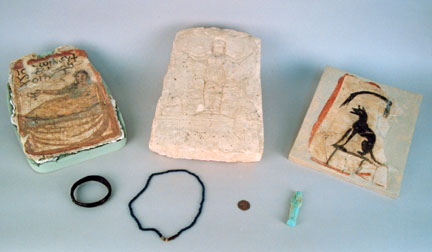
The town of Terenouthis in Egypt, today more commonly known as Kom Abou
Billou, lies beneath 1800 years of successive human occupation and the deposits
of annual Nile floods (map).
The main inhabitants back in Roman times were Egyptians influenced by Greco-Roman
culture. This diversity of culture was a result of the Greco-Macedonian
conquest of Egypt by Alexander the Great, followed by Rome's conquest in
31 BC, after the Battle of Actium. The varied population and diverse heritage
that endured in this country through Roman times and beyond can be identified
by the many different funerary customs visible in its tombs. In the earlier
part of the 20th century the University of Michigan excavated forty tombs
from this old Egyptian city, and the Kelsey Museum of Archaeology has attempted
to recreate the culture
and life of Terenouthis. 
With conquest, Greeks and Romans came to Egypt, bringing with them new cultural traditions and beliefs. Under Roman control Egypt was forced to use the currency of the empire, to pay taxes to it and to follow its laws. Over time and through intercultural marriages, people living in Egypt became more and more mixed and diverse, incorporating many different cultural practices into their everyday lives. Of the many tombs excavated from Terenouthis we will analyze the contents of just one composite grave.** From this investigation, we will show how its contents portray the many different cultural influences that one single individual in Egypt would have felt in life and represented in death.
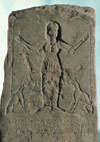 Items
recovered from the grave included a stele, painted plaster from the tomb's interior, jewelry, a Roman coin dating
to the end of the third century AD, and an ushabti.
From these artifacts, much can be inferred about the deceased's life in
Terenouthis. From the stele alone we know that the tomb belonged to a fourteen-year
old girl named Sarapous. The daughter of Euanthes, we are told she was a
devoted wife and that she died childless.
Items
recovered from the grave included a stele, painted plaster from the tomb's interior, jewelry, a Roman coin dating
to the end of the third century AD, and an ushabti.
From these artifacts, much can be inferred about the deceased's life in
Terenouthis. From the stele alone we know that the tomb belonged to a fourteen-year
old girl named Sarapous. The daughter of Euanthes, we are told she was a
devoted wife and that she died childless. 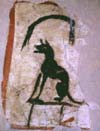 Moving further in the interpretation
of the stele, we can clearly see in it a mixture of Greek and Egyptian customs.
It bears a female figure clothed in a chiton, a tunic-like garment that
was commonly worn in Greece, in the Ionic style, over which a Doric-style
chiton was overlaid. Doric and Ionic clothing demonstrates Greek influence,
but showing the figure with legs in a profile position and with parted hair
is definitely in the Egyptian fashion. Another Egyptian characteristic exhibited
on the stele are the carved jackals on either side of the figure. The jackal
was an animal sacred to Anubis, God of the Dead, and is very common in Egyptian
funerary art. A jackal also appears on one of
the pieces of painted plaster used to decorate the tomb's interior.
Moving further in the interpretation
of the stele, we can clearly see in it a mixture of Greek and Egyptian customs.
It bears a female figure clothed in a chiton, a tunic-like garment that
was commonly worn in Greece, in the Ionic style, over which a Doric-style
chiton was overlaid. Doric and Ionic clothing demonstrates Greek influence,
but showing the figure with legs in a profile position and with parted hair
is definitely in the Egyptian fashion. Another Egyptian characteristic exhibited
on the stele are the carved jackals on either side of the figure. The jackal
was an animal sacred to Anubis, God of the Dead, and is very common in Egyptian
funerary art. A jackal also appears on one of
the pieces of painted plaster used to decorate the tomb's interior.
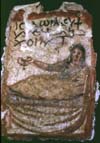 Other
'outside' influence is noted on another piece of painted plaster from the
tomb. The scene depicts a reclining deity, probably
partaking of some funerary meal. This is a very common motif in Greco-Roman
representations of death and burial.
Other
'outside' influence is noted on another piece of painted plaster from the
tomb. The scene depicts a reclining deity, probably
partaking of some funerary meal. This is a very common motif in Greco-Roman
representations of death and burial.
 Another
idea common to Greek and Roman culture was the notion that the deceased
must cross the River Styx to enter the underworld. A payment was believed
to be necessary to make it across the river, so it was common for individuals
to be buried with a coin. This particular tomb of Sarapous contained a Roman coin. Besides showing a possible belief in the
myth of the Styx, the coin's presence is also helpful in dating
the tomb.
Another
idea common to Greek and Roman culture was the notion that the deceased
must cross the River Styx to enter the underworld. A payment was believed
to be necessary to make it across the river, so it was common for individuals
to be buried with a coin. This particular tomb of Sarapous contained a Roman coin. Besides showing a possible belief in the
myth of the Styx, the coin's presence is also helpful in dating
the tomb.
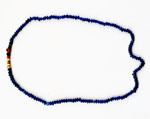 Several
other conclusions can be drawn from the jewelry found in the tomb. While
the glass bracelet and beaded necklace
are beautiful items, they were also extremely common objects to find in
Egypt.
Several
other conclusions can be drawn from the jewelry found in the tomb. While
the glass bracelet and beaded necklace
are beautiful items, they were also extremely common objects to find in
Egypt.
 There
is no gold present in the tomb so Sarapous was not likely to be a member
of the highest and wealthiest social class. The ushabti
buried with the tomb gives further evidence of this. Ushabti are very common
in Egyptian burials, being placed there to become servants for the deceased
in the afterlife. Many graves have numerous ushabtis within them; Sarapous
only one. The presence and nature of the ushabti and jewelry can definitely
distinguish this tomb's owner as a kind of 'middle class' citizen.
There
is no gold present in the tomb so Sarapous was not likely to be a member
of the highest and wealthiest social class. The ushabti
buried with the tomb gives further evidence of this. Ushabti are very common
in Egyptian burials, being placed there to become servants for the deceased
in the afterlife. Many graves have numerous ushabtis within them; Sarapous
only one. The presence and nature of the ushabti and jewelry can definitely
distinguish this tomb's owner as a kind of 'middle class' citizen.
This tomb in Terenouthis is just one among many. The materials obtained from this site demonstrate many interesting connections between Greek, Roman and Egyptian funerary traditions, suggesting that a very diverse population, with a multi-cultural way of life, once inhabited this small town in Roman Egypt. Excavations, such as those of the University of Michigan at Terenouthis, provide a glimpse into history and allow archeologists to recreate and learn about the past.
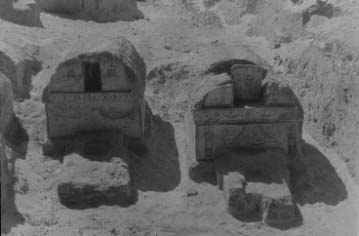
![]() Tour of objects
from Terenouthis
Tour of objects
from Terenouthis
**Please note: this "assemblage" was created solely for educational purposes. While all of the objects discussed here were excavated at the site of Terenouthis, it must be emphasized that they were not found in a single tomb. A full explanation of this class project is found on the introductory page for this website.